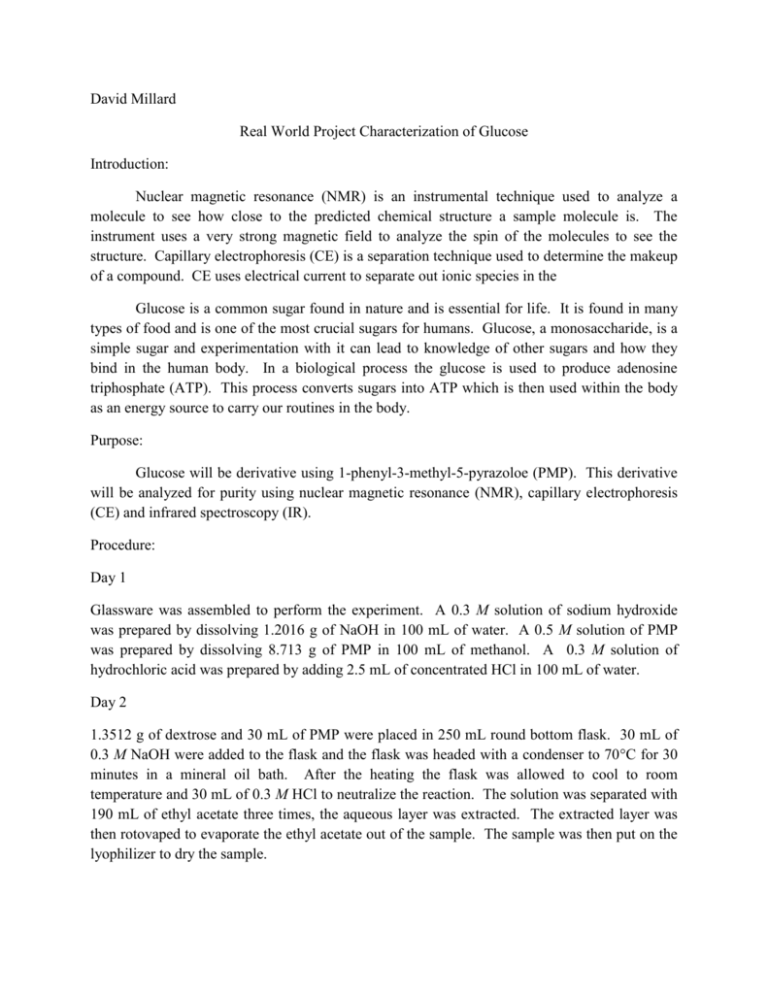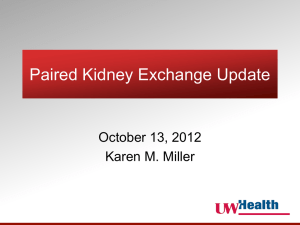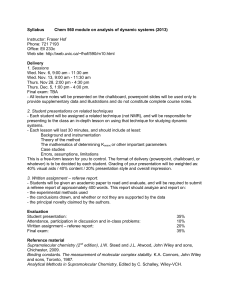Real World Doc
advertisement

David Millard Real World Project Characterization of Glucose Introduction: Nuclear magnetic resonance (NMR) is an instrumental technique used to analyze a molecule to see how close to the predicted chemical structure a sample molecule is. The instrument uses a very strong magnetic field to analyze the spin of the molecules to see the structure. Capillary electrophoresis (CE) is a separation technique used to determine the makeup of a compound. CE uses electrical current to separate out ionic species in the Glucose is a common sugar found in nature and is essential for life. It is found in many types of food and is one of the most crucial sugars for humans. Glucose, a monosaccharide, is a simple sugar and experimentation with it can lead to knowledge of other sugars and how they bind in the human body. In a biological process the glucose is used to produce adenosine triphosphate (ATP). This process converts sugars into ATP which is then used within the body as an energy source to carry our routines in the body. Purpose: Glucose will be derivative using 1-phenyl-3-methyl-5-pyrazoloe (PMP). This derivative will be analyzed for purity using nuclear magnetic resonance (NMR), capillary electrophoresis (CE) and infrared spectroscopy (IR). Procedure: Day 1 Glassware was assembled to perform the experiment. A 0.3 M solution of sodium hydroxide was prepared by dissolving 1.2016 g of NaOH in 100 mL of water. A 0.5 M solution of PMP was prepared by dissolving 8.713 g of PMP in 100 mL of methanol. A 0.3 M solution of hydrochloric acid was prepared by adding 2.5 mL of concentrated HCl in 100 mL of water. Day 2 1.3512 g of dextrose and 30 mL of PMP were placed in 250 mL round bottom flask. 30 mL of 0.3 M NaOH were added to the flask and the flask was headed with a condenser to 70°C for 30 minutes in a mineral oil bath. After the heating the flask was allowed to cool to room temperature and 30 mL of 0.3 M HCl to neutralize the reaction. The solution was separated with 190 mL of ethyl acetate three times, the aqueous layer was extracted. The extracted layer was then rotovaped to evaporate the ethyl acetate out of the sample. The sample was then put on the lyophilizer to dry the sample. Day 3 The sample was removed from the lyophilizer and 190 mL was added to dissolve the sample and the sample was then rotavapped to remove more of the ethyl acetate. The sample was again lyophilized to remove out the water. Day 4 The product was analyzed by NMR and CE. A proton NMR was performed as well as a 13C. An IR was recorded as well. Data: Spectra from NMR are in lab manual CE Method for CE PMP spectra peak Product peak Conclusion: Overall, the procedure of the experiment was simple to follow. A difficult point in the reaction was the maintaining of the temperature of 70°C. The temperate we held at was approximately 73°C. The scale at which we ran the experiment was three times what another student was running the experiment for their independent study. The NMR spectrum that was gathered showed a large solvent peak in the proton NMR. The solvent peak appeared between 4.6 and 4.8 which we believed to mask some of the peaks in our product. The 13C NMR and CE data was very reliable. The CE PMP peak shows a large peak around 5 minutes which does not appear in the spectra with the product. This shows that the PMP fully reacted with the starting materials forming the glucose. The IR data that was analyzed was very promising. The data showed a lack of a ketone, which is part of the PMP. This shows that the main feature of the PMP was driven off in our sample. The student performing this experiment for his independent study did not perform the second hydration and the data obtained from his was not as neat. The second hydration proved to be a very important part of the procedure. Reference: Thibault, Pierre, and Susumu Honda. Capillary Electrophoresis of Carbohydrates. Totowa, NJ: Humana, 2002.







